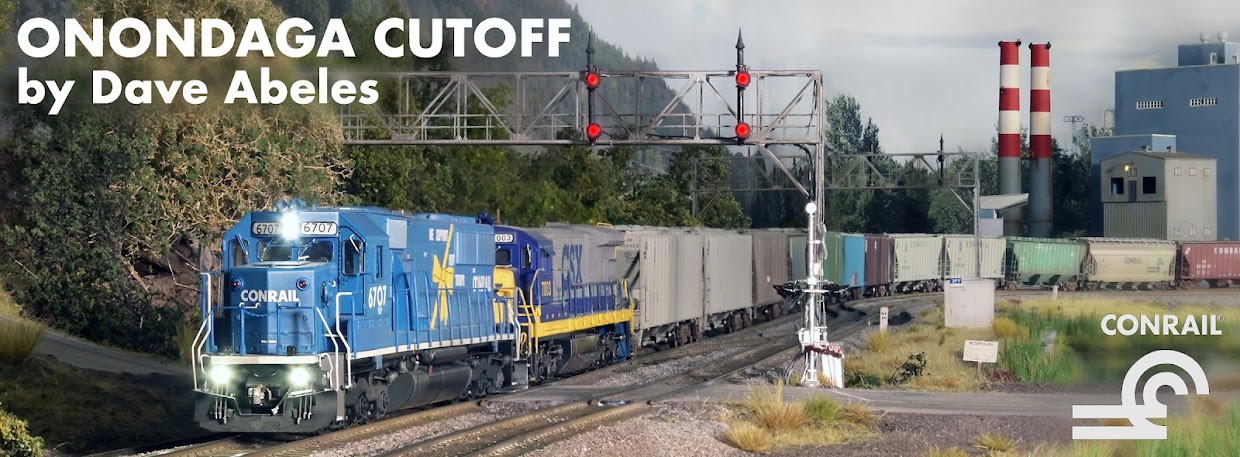The construction of your layout can tell you a lot about yourself.
Take this Onondaga Cutoff 'deep staging' project, for example. The idea started organically, without a clear path forward at first, but always in line with the vision of an exceptional operating experience. Once the idea started it was widely shared with others I trust to vet its weaknesses, and to ensure it was well thought out. It's measured, constructed and installed to stand the test of time and to provide error-free operation. And, once it started, the project hasn't stopped much for other modeling endeavors except for glue to cure or paint to dry. The progress is really settling in, a nice smooth grade down from the right, around the curve towards the new lowest level.
Taking a step back I am quite sure that most things in my life that I can control follow all those same adages. Most things I am involved in did not come from a pre-planned set of goals, but they almost all serve a central vision for life. I have learned in my 44-1/3 years so far that most things in my world are better with the influence of others that are experts in their way, or that know me well enough to give me honest feedback on how I might improve things. Once I decide to build something, I want to do it once, and do it right: taking hours and hours to create something that doesn't work well or to make a repair that can't hold does not suit me. And once I decide to jump in, it's with both feet - unfinished projects cloud the mind and the schedule, and make the satisfaction of moving on nearly impossible.
None of that, of course, is to say that it is easy, or even that I take my own advice all the time. Nope, I am routinely surprised (and sometimes frustrated) by the things I do, but I do hope to learn from each experience and carry that going forward. Life isn't lived on a shelf or on paper; it's lived by doing. The key in my view is to spend enough time planning and considering and sharing any idea first so that the act of doing is more effective, more present, and less prone to the erosion that time will inevitably bring to us all.
Some thoughts for you all on a Monday night as I reflect on progress so far on this deep staging installation.
In the past few nights, we cut in the switch to the existing track.
This process begins by selecting a location for the switch, and with an install like this that is not an easy question. It was moved back and forth a variety of times to find a location with acceptable curves to connect the diverging route of this #6 switch to the new trackage on the ramp.
And, of course, even once the location is determined, this is tough construction to do well. Here you can see how it is:
We have a fixed layer above, with wiring and lighting already installed, and the existing Island track below. It is amazing how many tools I used for this: Dremel with both cut-off disc and wire brush, putty knife, screwdrivers, drill, utility knife, adhesive caulk, pliers of several types, nippers of several sizes, bright boy eraser, several jeweler's files, just to name a few. It was a congested mess keeping things going! And after a few cuts from dealing with the sharp metal edges, I was ready to move on.
Again, measuring three times and cutting once, we were able to get all things set so that the track dropped into place perfectly. The flex track took some massaging but in the end the curves all measured out greater than 22" radius through this stretch which is enough to help things stay on the rail. Of course we would like wider radius, but that is simply not an option here. We will deal with sharp curves like the prototype does: by limiting speeds and which sorts of equipment are allowed down the hill. I spread the adhesive, and laid the track in the same manner as with the last post, but of course this was harder where we were under that top layer. Then all of the new install was weighted to allow it to cure and bond to the subroadbed.
You'll notice no cork or foam roadbed here: where clearances are critical, and where trackage is complicated, you need a minimal vertical cross section as well as a good firm bond. We have both and the results maximize clearance and rigidity, which was the goal. It comes at the expense of noise when trains roll through, but this is hidden trackage and noise is not a major concern.
While it cured, I had time then to install the Tortoise (by Circuitron) switch machines.
These went in better than expected given the location. I was glad to have made the holes bigger than advised, settling on 1/2" holes for the wire instead of 1/4". With no ballast going in down here, there is no concern about the hole being a bit larger and it will help guarantee mechanical reliability in a tight area.
Finally, we see the new track in place, with switches lined normal for now pending the wiring of the new switch machines and the full new control panel, which is currently under development. Once that is in place, I'll bring you up to date on the final pieces of getting this track in service!






No comments:
Post a Comment